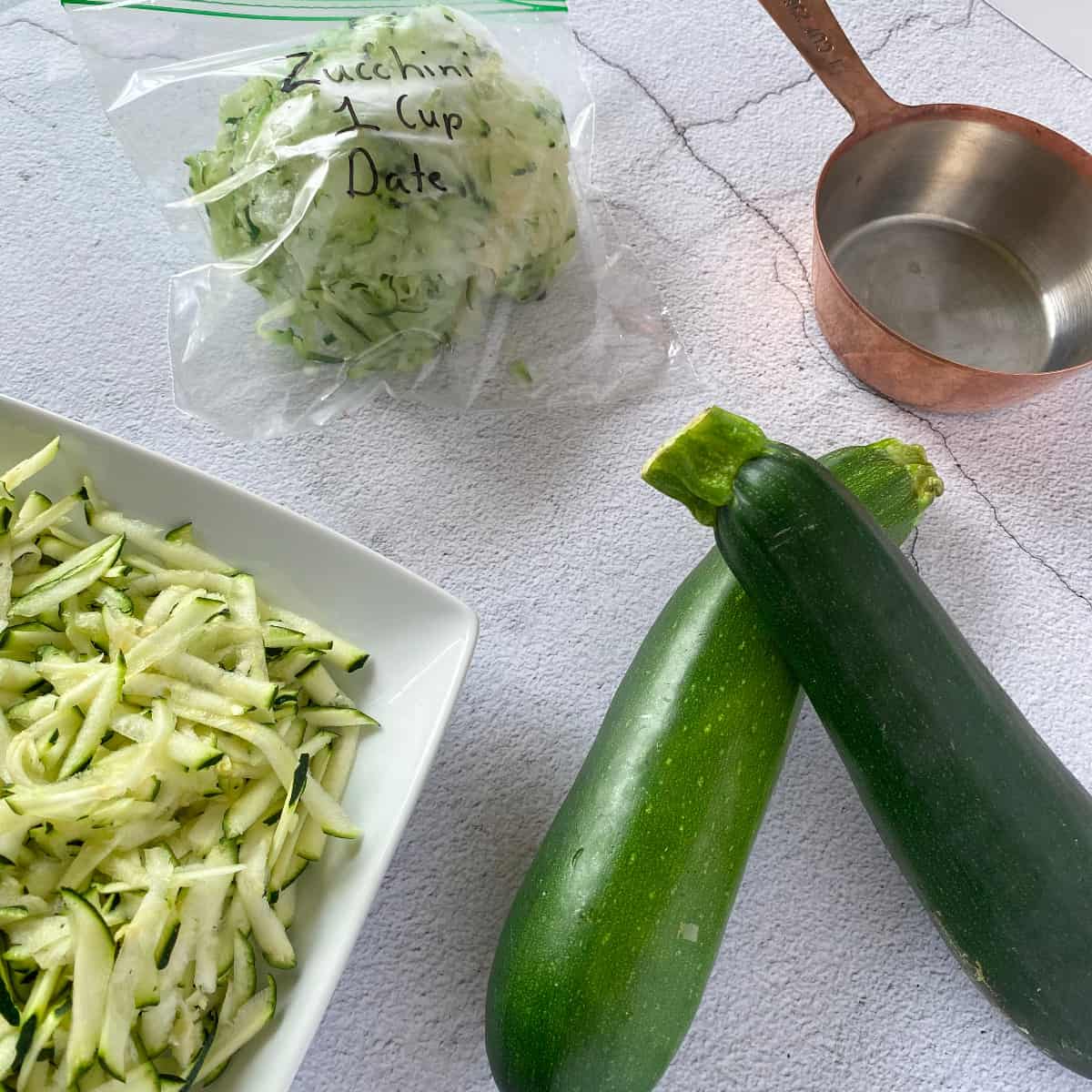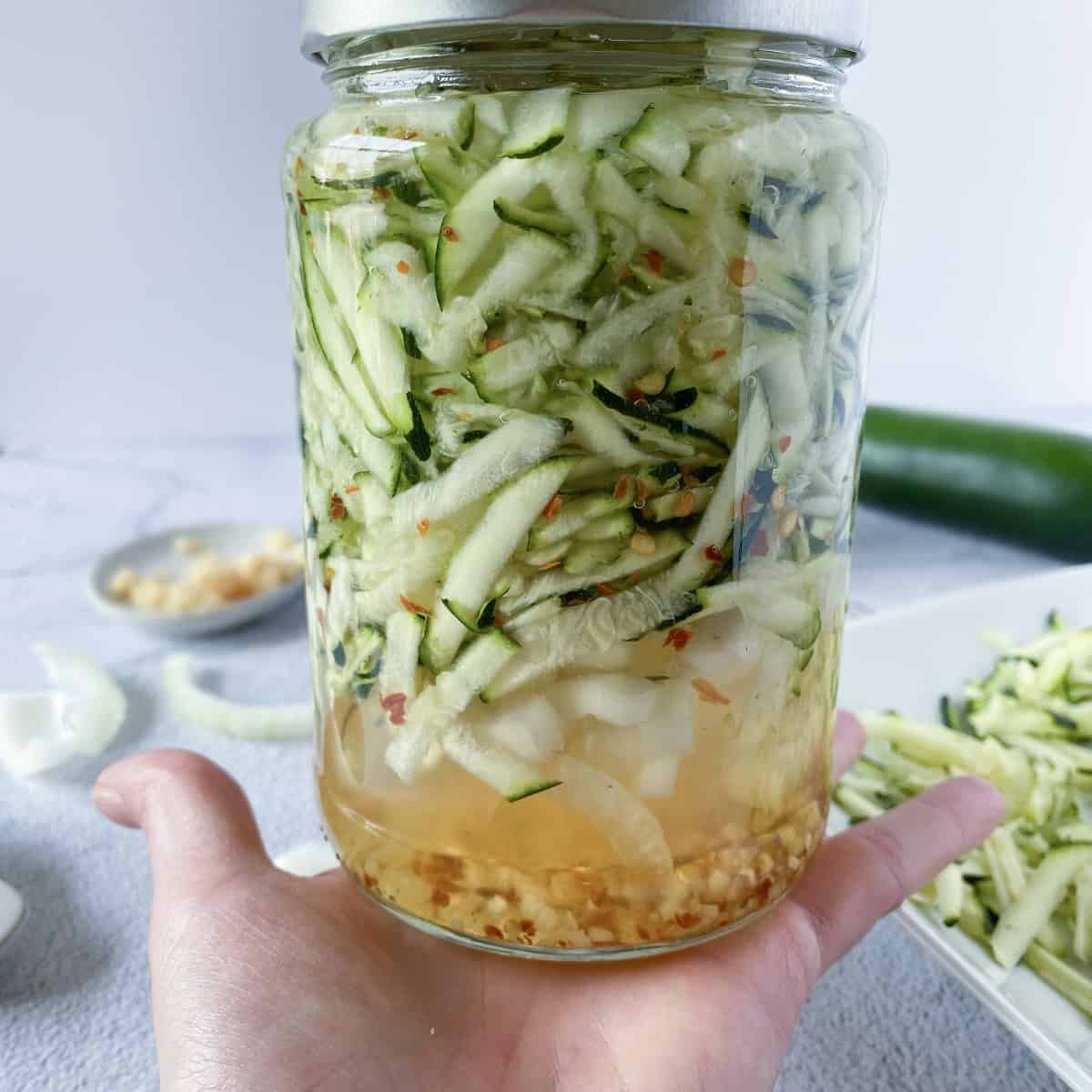Learn how to prevent and treat powdery mildew on your zucchini leaves organically by using a common household staple…buttermilk.
So you’re excited to finally be growing and enjoying your bounty of fresh, homegrown zucchini. Then you go out into the garden and notice your normally green and vibrant zucchini leaves are starting to lose their luster with a white powdery substance all over the leaves.
Unfortunately, your zucchini has likely just become a victim to powder mildew.
I’m constantly trying out organic options for my garden. I have a neighbor from Europe who has a beautiful garden. When I asked her what her secret is, she said two things: iodine and buttermilk.
I was very intrigued by this combination.
I was already using a milk solution to treat black spot on my roses so buttermilk made sense to me. I decided to give it try when I first spotted powdery mildew on my zucchini leaves and was amazed at how quickly it worked.

Jump to:
- What is powdery mildew?
- Identification
- Common plants that powdery mildew effects
- Other common problems with growing zucchini
- How to control powdery mildew
- The steps to treating powdery mildew organically
- Organic buttermilk spray for powdery mildew
- Other organic treatments
- Tips for success
- Frequently asked questions
- What to do with the leftover zucchini?
What is powdery mildew?
Powdery mildew is a common fungal disease that effects a variety of plants.
Identification
Powdery mildew usually starts as small white circles on the top side of the leaves. As the disease progresses, the white substance spreads and begins to look like a white powder similar to baby powder. If left untreated, It can spread to the underside of the leaves and they will eventually wilt, become discolored, and die.

The two images above look very different but they are both powdery mildew.
Common plants that powdery mildew effects
Powdery mildew is not a disease that effects only zucchini. Here is a list of the most common plants that are prone to powdery mildew:
- squash
- pumpkins
- cucumbers
- melons
- tomatoes
- eggplant
- peppers
- beans
- peas
- flowers like begonias or roses
Other common problems with growing zucchini
I have had several issues with zucchini over the years. These are the three most common issues I have encountered:
Squash Vine Borer
This little critter is the larvae of a black and orange moth that burrows into the stem of the zucchini, causing it to wilt and die within days. Visit the Old Farmers Almanac to learn how to identify and treat squash vine borers.

Squash bugs
These little bugs multiple quickly causing a complete infestation of the plant. The picture below shows the eggs laid by squash bugs. The eggs are usually laid on the underside of the zucchini leaves. If you see this, pick them off carefully to prevent an infestation. Duck tape works well to remove the eggs off of the leaves.
To learn more about squash bug identification, prevention, and control click here.

How to control powdery mildew
Prevention
- Start with healthy, disease resistant varieties.
- Use quality soil and compost in your garden to encourage healthy plants and beneficial organisms.
- Make sure your plant gets plenty of sunlight.
- Avoid growing plants too close together. This is my personal #1 offense.
- Prune the plant to avoid overcrowded stems with poor circulation.
- Plant the zucchini in an area that gets a breeze. If this is not possible then you may consider adding a fan to circulate air.
- Water from overhead, on windy days only, as this can wash off spores but still allow the plant leaves to dry and not encourage other diseases that are common from watering overhead.
- If one plant becomes heavily infected then remove it to prevent it from spreading to other nearby plants.
Early treatment is best
If preventative measures did not work and you are still battling powdery mildew, then it’s time to treat.
The earlier the better.
Powdery mildew is quite easy to treat if caught early.
The steps to treating powdery mildew organically
- The first step in the process is to determine how progressed the disease is.
- If the powdery mildew is just on a few leaves then prune the leaves off of the plant and discard in the trash (not compost bin), then spray with organic solution to avoid the spread to other areas of the plant.
- If a large number of leaves have little white circles on the leaves, spray the plant generously with an organic spray that works against powdery mildew. It is best to spray in the evening when the bees are not active and the hot sun is not hitting freshly treated leaves which may stress the plant.
- For large patches of thick white powdery mildew, you may want to water from overhead to wash some of the powder off prior to treating. Just watch out for the over spray hitting other plants.
- If the disease has progressed to the point where the whole plant is effected and the leafs are wilting and dying it may be best to pull out the plant to prevent spread to other plants.
- Continue to spray the plant every 2-3 days and watch for improvement. If it is not responding well within 1 week, try one of the other other organic treatments listed below.
Organic buttermilk spray for powdery mildew
Using a diluted milk solution for organic gardening has been around for ages and is used to treat a variety of plant issues. As I previously mentioned, I used a diluted milk solution on my roses when they got black spot and it works great.
Why does milkand buttermilk work to treat plant fungal diseases? The exact reason isn’t known but it is thought that capsein may play a role.
There are varying opinions on how much to dilute milk solutions. There is significantly less information on appropriate ratios for diluting buttermilk.
So I have learned by trial and error.
The most effective dilution that I have found was is using 1 part buttermilk to 3 parts water. Just add ¼ cup buttermilk and ¾ cup water to a spray bottle and shake well.
Spray the top and underside of all of the zucchini leaves every 2-3 days until the powdery mildew is gone.
Other organic treatments
Baking soda
Another common treatment for powdery mildew is sodium bicarbonate (aka baking soda). Add 1 teaspoon to 1 quart of water and spray the plant thoroughly.
Iodine, Sulfur, lime-sulfur, and neem oil.
Iodine, sulfur, lime-sulfur, and neem oil are all common organic treatments for treatment of fungal disease on plants.
Tips for success
- Preventative measures results in long term success.
- Early intervention yields the best result.
- Treat according to how infected the plant is.
- Spray in the evening to avoid spraying bees when they are most active and to avoid stressing the plant by spraying in the hot sun.
- Spray both the top and underside of the leaves.
- Always discard affected plants in the burn pile/trash and not the compost bin.
- Always use buttermilk before its expiration date.
- Buy cheap spray bottles and keep the buttermilk solution in the refrigerator to use as needed (remember to keep the expiration date in mind).
Frequently asked questions
Powdery mildew is a common fungal disease that effects many plants and looks like a white powdery substance all over the leaves.
1. The first step in the process is to determine how progressed the disease is.
2. If the powdery mildew is just on a few leaves, prune the leaves off of the plant and discard in the trash (not compost bin), then spray with organic solution to avoid the spread to other areas of the plant.
3. If a large number of leaves have little white circles on the leaves, spray the plant generously with an organic spray that works against powdery mildew. It is best to spray in the evening when the bees are not active and the hot sun is not hitting freshly treated leaves which may stress the plant.
4. For large patches of thick white powdery mildew, you may want to water from overhead to wash some of the powder off prior to treating. Just watch out for the over spray hitting other plants.
5. If the disease has progressed to the point where the whole plant is effected and the leafs are wilting and dying, it may be best to pull out the plant to prevent spread to other plants.
6. Continue to spray the plant every 2-3 days and watch for improvement. If it is not responding well within 1 weeks, try one of the other other organic treatments listed below.
Powder mildew can present in several ways. Powdery mildew usually starts as small white circles on the top side of the leaves. As the disease progresses, the white substance spreads and begins to look like a white powder similar to talc. If left untreated It can spread to the underside of the leaves and they will eventually wilt, become discolored, and die.
squash
pumpkins
cucumbers
melons
tomatoes
eggplant
peppers
beans
peas
flowers like begonias or roses
Absolutely! There are many organic sprays that target fungal plant diseases. Milk and buttermilk solutions, neem oil, sulfur, and iodine solutions are the most common organic treatments.
There are many things you can do to try and prevent powdery mildew.
1. Start with healthy, disease resistant varieties.
2. Use quality soil and compost in your garden to encourage healthy plants and beneficial organisms.
3. Make sure your plant gets plenty of sunlight.
4. Avoid growing plants too close together. This is my personal #1 offense.
5. Prune the plant to avoid overcrowded stems with poor circulation.
6. Plant the zucchini in an area that gets a breeze. If this is not possible then you may consider adding a fan to circulate air.
7. Water from overhead, on windy days only, as this can wash off spores but still allow the plant leaves to dry and not encourage other diseases that are common from watering overhead.
8. If one plant becomes heavily infected, remove it to prevent it from spreading to other nearby plants.
What to do with the leftover zucchini?
Now that you have healthy zucchini plants that produce an abundance of zucchini, what should you do with the extra?
My two favorite methods for using up leftover zucchini is pickling or freezing shredded zucchini.
I love to shred leftover zucchini and freeze in portioned sizes that are ready to use when thawed.

Or you can enjoy these sweet and spicy zucchini pickles. They are seriously THE BEST!

Enjoy!


Leave a Reply